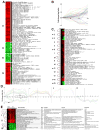Expression signatures of the lipid-based Akt inhibitors phosphatidylinositol ether lipid analogues in NSCLC cells
- PMID: 21551261
- PMCID: PMC3132820
- DOI: 10.1158/1535-7163.MCT-10-1028
Expression signatures of the lipid-based Akt inhibitors phosphatidylinositol ether lipid analogues in NSCLC cells
Abstract
Activation of the serine/threonine kinase Akt contributes to the formation, maintenance, and therapeutic resistance of cancer, which is driving development of compounds that inhibit Akt. Phosphatidylinositol ether lipid analogues (PIA) are analogues of the products of phosphoinositide-3-kinase (PI3K) that inhibit Akt activation, translocation, and the proliferation of a broad spectrum of cancer cell types. To gain insight into the mechanism of PIAs, time-dependent transcriptional profiling of five active PIAs and the PI3K inhibitor LY294002 (LY) was conducted in non-small cell lung carcinoma cells using high-density oligonucleotide arrays. Gene ontology analysis revealed that genes involved in apoptosis, wounding response, and angiogenesis were upregulated by PIAs, whereas genes involved in DNA replication, repair, and mitosis were suppressed. Genes that exhibited early differential expression were partitioned into three groups; those induced by PIAs only (DUSP1, KLF6, CENTD2, BHLHB2, and PREX1), those commonly induced by PIAs and LY (TRIB1, KLF2, RHOB, and CDKN1A), and those commonly suppressed by PIAs and LY (IGFBP3, PCNA, PRIM1, MCM3, and HSPA1B). Increased expression of the tumor suppressors RHOB (RhoB), KLF6 (COPEB), and CDKN1A (p21Cip1/Waf1) was validated as an Akt-independent effect that contributed to PIA-induced cytotoxicity. Despite some overlap with LY, active PIAs have a distinct expression signature that contributes to their enhanced cytotoxicity.
© 2011 American Association for Cancer Research.
Conflict of interest statement
The authors have no conflict of interest.
Figures




References
-
- LoPiccolo J, Granville CA, Gills JJ, Dennis PA. Targeting Akt in cancer therapy. Anticancer Drugs. 2007;18:861–74. - PubMed
-
- Brognard J, Clark AS, Ni Y, Dennis PA. Akt/protein kinase B is constitutively active in non-small cell lung cancer cells and promotes cellular survival and resistance to chemotherapy and radiation. Cancer Res. 2001;61:3986–97. - PubMed
-
- Clark AS, West K, Streicher S, Dennis PA. Constitutive and inducible Akt activity promotes resistance to chemotherapy, trastuzumab, or tamoxifen in breast cancer cells. Mol Cancer Ther. 2002;1:707–17. - PubMed
-
- Granville CA, Memmott RM, Gills JJ, Dennis PA. Handicapping the race to develop inhibitors of the phosphoinositide 3-kinase/Akt/mammalian target of rapamycin pathway. Clin Cancer Res. 2006;12:679–89. - PubMed
Publication types
MeSH terms
Substances
Grants and funding
LinkOut - more resources
Full Text Sources
Molecular Biology Databases
Miscellaneous

